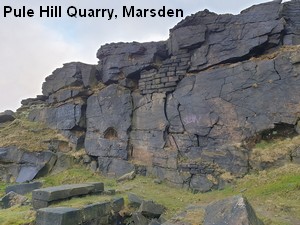.jpg)
Many Sites of Special Scientific Interest (SSSI) are designated for their geological interest. During the last three years WYGT members have taken part in Natural England surveys of geological SSSIs in Yorkshire and Northumberland, coordinated by The Geology Trusts. We visited each site to see if the important rocks/fossils/minerals/features for which they are designated are still visible or could be made visible and, in some cases, whether they are still accessible for the general public.
During the winter of 2020/2021 we visited twenty selected Yorkshire SSSIs across the county, sometimes in difficult weather conditions, taking photos and recording grid references so that future surveyors could return in years to come to see what changes have taken place. A second survey took place during autumn 2022 to look at SSSIs along much of the Jurassic and Cretaceous coastline between Scarborough and Bridlington. Surveying was highly dependent on weather and tides and it was good that Natural England gave us the go-ahead before the autumn set in. The surveying took seven days in total, with all the committee involved in some way.
A third survey was planned during the autumn of 2022 and two of the committee offered to survey the Lindisfarne SSSI in Northumberland which covers 45 km of the coastline between Berwick-upon-Tweed and Bamburgh and which includes Holy Island. In this case we were checking on several aspects of the coastline, which included the igneous rocks of Holy Island, sedimentary rocks along the Spittal to Cocklawburn cliffs south of Berwick and also the extent to which the coastline was affected by depositional and erosional processes, particularly as there is net accumulation of sand on the shoreline around Holy Island, in contrast with much of the east coast of England. All of the group have enjoyed the surveying process and learned a great deal about rocks and geological features which otherwise we might not have studied so closely. Most SSSIs still showed the features for which they were designated, up to thirty years ago. Some sites had been managed and improved, although many were very overgrown and, in at least two cases, were dangerous to enter. We hope that future surveys on behalf of Natural England will benefit from our efforts..
All of the group have enjoyed the surveying process and learned a great deal about rocks and geological features which otherwise we might not have studied so closely. Most SSSIs still showed the features for which they were designated, up to thirty years ago. Some sites had been managed and improved, although many were very overgrown and, in at least two cases, were dangerous to enter. We hope that future surveys on behalf of Natural England will benefit from our efforts..